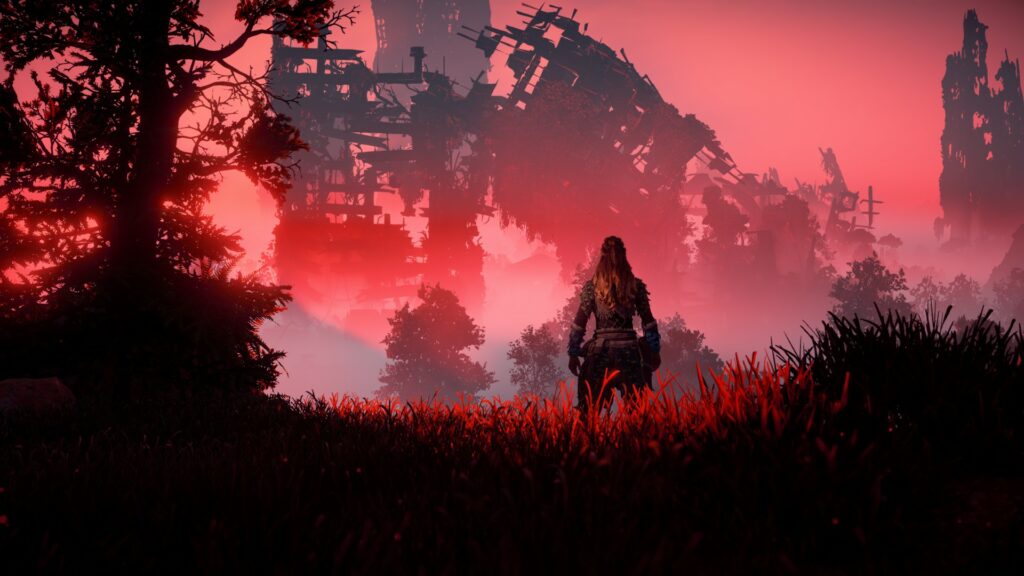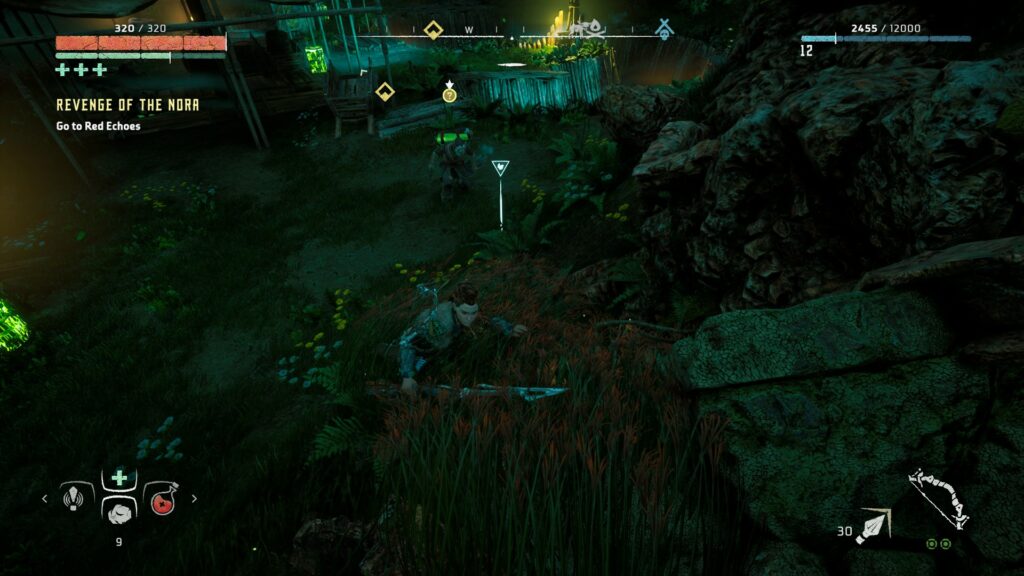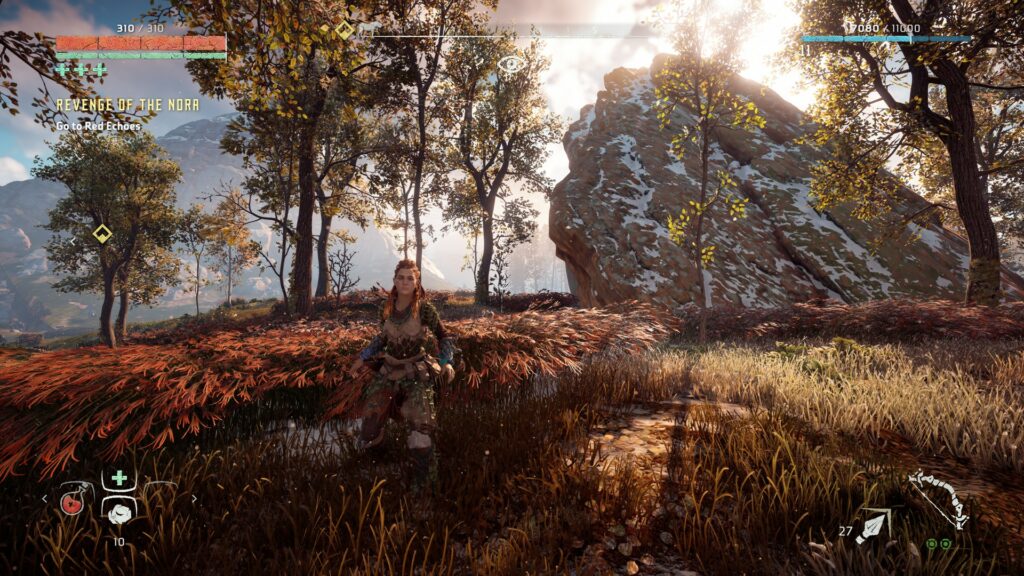I’m still not sure I like Horizon: Zero Dawn, though I’ve played for almost 8 hours now, I’m barely out of the starting area, and I have materials enough to supply arrows for a small army.
When I started out on Horizon: Zero Dawn I noticed many similarities with Kingdom Come: Deliverance, and not just because both are three words that don’t really mean anything separated by a colon. Both have the peculiar polish of an open-world action adventure title trying for mass appeal. But right off the bat, Horizon: Zero Dawn (I’m just going to call it Horizon now) had an advantage: the opening cutscene was genuinely intriguing and didn’t have me smashing buttons to figure out how to skip it (it’s spacebar, by the way). Something about the initial story was just well put together and provided an air of mystery without dumping too much exposition on you.
While it had the opening cutscene down, though, it quickly drifted into tutorial land. And I don’t mean that metaphorically – I mean the physical…err… digital land you are constrained to while you finish the first four or five main story missions and face the narrative threshold guardians. At first, you play first as a younger version of yourself exploring the ruins of a technological past before moving on as the adult you, ready to face the “Proving” which will allow you access to the whole map. Much like Breath of the Wild, this second phase is still constrained to a small section of the world, but you won’t really notice it unless you immediately head for the edges of the map…which is what I normally do.
Once again, Dark Souls had it right: set up a quick conflict, show some cool things that you eventually discover, and drop you into the game. Along the same line as Metroidvanias, areas are opened up as you explore, find items, kill things, and level up. Dark Souls (and Demon’s Souls and most Metroidvanias, for that matter) had what might be considered a “tutorial land” in the form of the Undead Asylum with a literal threshold guardian in the form of the Asylum Demon. What makes those different from these Assassin-likes (including Horizon) is that the threshold guardian is not a story mission but a microcosm of the core gameplay loop that you’ll be repeating for the entire game.
It’s in this tutorial land of Horizon that you get your first taste of the open world and what you’ll be doing most of the time. And what you’ll be doing is gathering plants. Lots and lots of plants. This assessment may not be totally fair as I likely spent more time gathering plants than I strictly had to, but if gamers are known for anything it’s collecting things.
The plants you collect are directly tied to both your damage output (wood for arrow shafts and some materials for other weapons) and healing capacity (red plants that function as a continuous healing pool), so obviously I wanted to gather as many as possible. The trouble arises when you can carry an infinite amount of some things, but not others. I can understand why they don’t want you to have an infinite healing pool, but why is it that while I can only carry 20 arrows I can also carry 250+ arrow shafts? This is not an exaggeration – this is the situation I ended up in when finishing the tutorial area. This sort of thing is also why I don’t have people track arrows in D&D – it’s a pain and adds little to the experience in most circumstances. You might be thinking that they want the combat portions to put you under a resource constraint, but this is not the case; you can quickly craft more arrows during combat – time even slows down while you do it.
Now, why did I have 250 arrow shafts at my disposal? Well, the main draw of this game is fighting robot dinosaurs (to the point that there are more robot dinosaurs than actual wildlife), so I wanted to try as much of that as I could. Each time you fight, you can use your pool of healing herbs to heal over time if you get hit. Once the fight is over, you go back to gathering the red herbs that heal you to replenish your supply. However, the icon which indicates the closest shrubbery is the same for all plants and there are a heck of a lot of plants in general on screen at any given time, making it difficult to pick out the healing ones before you’re already standing on top of it. Since you can carry an infinite number of arrow shafts, I’d often arrive and just pick the arrow plant anyway while I was searching for the healing plants.
That’s probably enough talking about my plant collection, but I want to stress that I spent a significant portion of my time in game doing it, so the large section of this review is merely proportional.
Combat in games is a tough one for me. I want things to be challenging, and most games are not challenging. Worse, increasing the in-game difficulty usually increases the difficulty, not the challenge (less health for you, more health for enemies is the classic example). For me, it’s also difficult to tell the difference since when you’re learning a game system the challenge may just come across as difficulty – and it’s easy to dismiss a challenging game as simply unfair.
With that disclaimer out of the way, my impression with the combat loop in Horizon was not favorable. While stealthed, you can one-hit kill most enemies, and the first upgrades I went for were the ones that let you one-hit kill the elite enemies. After that, my combat experiences went one of three ways: either I would stealth kill everything with little difficulty and a few rock throws, the mission I was on would decide that the people “helping” me had decided I was no longer being stealthy and I would have to tank through the enemies that were surrounding me, or I would stun the boss/elite enemy that I couldn’t stealth kill, hit it 15-20 times, stun it again, then rinse and repeat until it was dead (there’s a weapon you get at the start of the game that stuns the robot dinosaurs for a good 15 seconds).
At first, I tried to use the combat system without stealth or by using arrows to hit weak points. But when you are faced with making several precise shots with a bow and arrow against a moving target or just waiting in the tall grass and killing it in one hit, the answer becomes obvious (especially when the sniper bow ended up being slower and less powerful than my upgraded normal bow).
So let’s talk about stealth. I remember watching Yahtzee’s review of this game (Three years ago? That can’t be right) where he summed it up as “You’re visible when standing and invisible when crouching in a specific kind of grass.” I don’t remember much else about the review, but that stuck with me as a hilarious exaggeration. But no. That is the stealth mechanic. That picture above? Invisible, waited for the cultist to walk up, then stealth killed him. Later I was crouching, hidden entirely behind a box trying the same when a bandit saw me from halfway across the courtyard and brought all his friends. I’ll admit the invisibility grass does make stealth kills easier, but they really didn’t need to be.
My second-to-last point of contention with Horizon is again a problem endemic to Assassin-likes: things that are climbable are on set paths and usually bright yellow (or the equivalent), and everything that looks like it should be climbable but isn’t yellow is not. That rock to the right in the picture above? Not climbable. A sheer cliff face that has bits painted yellow? Climbable. A two foot ledge in front of you? 50/50, and all you might do is alert the people you’re trying to stealth past. I think the technology to make things look pretty has vastly outstripped the technology to make things play naturally.
My last niggle here is that when it comes to traversing the land, there’s no real gimmick – no physics-defying grappling hooks and parachutes, no paraglider, no wallrunning, no superpowers. This is a game with robot dinosaurs and we slowly ride around on a horse. Not a real horse of course – those must have gone extinct, replaced by robots. But while a robotic horse it may be, but it behaves exactly like a real horse down to the whinnies and barding flaps. Perhaps it’s a personal preference, but I’d kinda like my mount in the robot dinosaur game to be, you know, a dinosaur or maybe a crazy mechanical spider.
Okay. Anyway. Moving on: the missions themselves had an odd quirk: I often had them mostly completed by the time I picked them up. One mission has you getting food for an elderly woman. Because of my scavenging streak, I already had everything I needed. Another mission has you clearing out a bandit camp, which I had just finished clearing out on my way to pick up the mission from the green exclamation mark. Yet another has you clearing out some cultists, which I had already done because they attacked me while I was exploring. I honestly can’t say whether this is a flaw or a feature, but it does make for some strange cutscenes when the people are talking about people/robots I’ve already killed as being a threat or know something that they couldn’t possibly have learned due to the order I did things.
Before wrapping up, I’d like to touch on one last confusing part of this game: I can’t decide if the game is pretty. On the one hand, there’s plenty of graphical effects and grass, high resolution rock textures and outfit physics, and much more. But there’s also just something about it that feels off – like someone was asked to make a pretty landscape inspired by Skyrim with mods, rather than make a realistic one. This, combined with the game-like markers for climbing or stealth, make the world feel artificial and I can’t quite say if I like it.
I have a lot to say about this game, mostly because I want to like it. It feels polished (I didn’t have any of the technical issues with the port that some did), the main character and overarching plot was interesting, most mechanics are weirdly well-justified, and there’s a big open world to explore. I might return – I want to see if there are ancient places to delve into and I want to see how big the world really is. Maybe soon. On the other hand, finding a tower I had to climb to reveal the map really put a damper on my spirits, even if that tower was in the shape of a robot dinosaur. Little things like that make the game feel as if it’s lacking a heart. For now it goes to Tier Two, even though I may return to play sooner rather than later.


